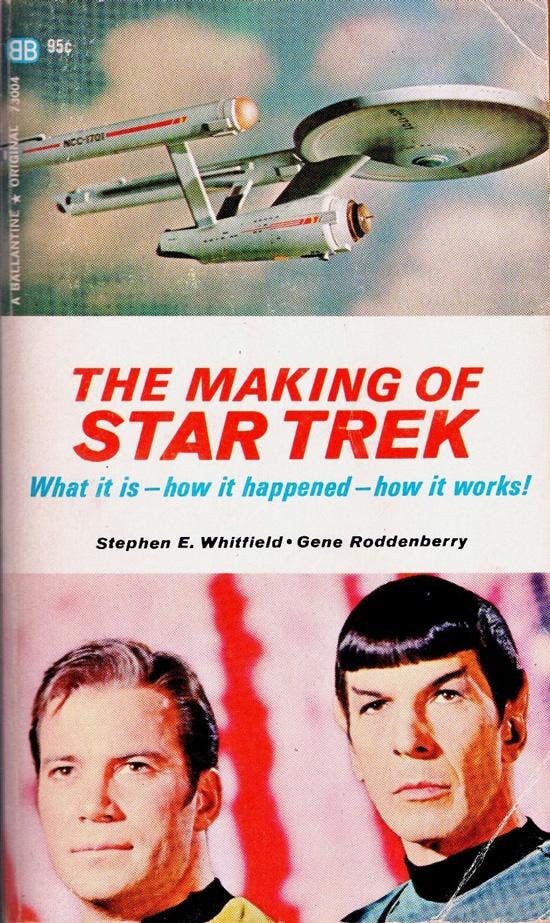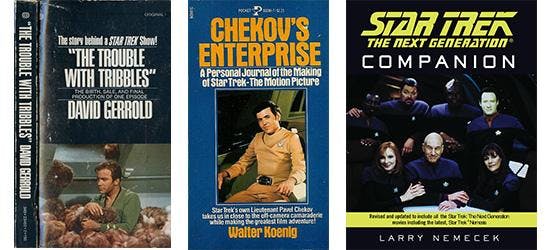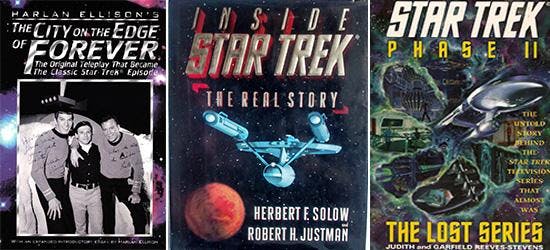Published Nov 19, 2014
Ten For Ward: 10 Favorite Star Trek "Behind the Scenes" Books
Ten For Ward: 10 Favorite Star Trek "Behind the Scenes" Books

For as long as I can remember, I’ve been fascinated by the process of making films and television. This, despite my utter lack of desire to actually be involved in that process. In particular, I enjoy reading or learning about story and script development, and how artists and designers come together to create the look of a movie or TV series. If it has to do with sets, props, models, wardrobe and countless other details that all collaborate to provide us with that we see on our screens, I’m probably interested in reading about it.
Naturally, this curiosity extends to Star Trek. In particular, I’ve always loved reading about the production of The Original Series, though each of the later shows obviously has plenty to keep me busy in this regard. There have been many books and articles written over the years covering just about every conceivable facet of this topic, and more continue to come out at a regular pace.
So, here’s ten of my all-time favorite books chronicling behind-the-scenes aspects of Star Trek in its all its various incarnations. Presented here in order of original publication:

The Making of Star Trek, by Stephen E. Whitfield & Gene Roddenberry (September 1968) – The father of them all, written and published while the original series was still in production! Something of a time capsule from that period, the book presents the history of the show’s creation and evolution from initial concept through its second season. This tome is a must-have for any hardcore fan.
The Trouble With Tribbles, by David Gerrold (April 1973) – Unlike most of these books, which take deep dives at an entire series, here we have our first extended look at the “life cycle” of a single episode; one of the most popular hours of Star Trek, ever, and provided to us by the man who wrote it. Everything about the tale’s genesis is here, from initial concept notes to scripts and revisions to the production of the episode once Mr. Gerrold sold his story outline to writer-producer Gene L. Coon. Long out of print, this wonderful nugget of Star Trek history is available in electronic format from Mr. Gerrold’s website: http://www.gerrold.com/book/the-trouble-with-tribbles/

Chekov’s Enterprise: A Personal Journal of the Making of Star Trek: The Motion Picture, by Walter Koenig (February 1980) – A very candid on (and off!) set diary from the perspective of Lieutenant Chekov himself, this books provides a “You are there” look inside the daily grind of producing the very ambitious first Star Trek film. Mr. Koenig gives us welcome insight into the process of the cast reacquainting themselves with the roles they thought they had left behind years earlier, as well as the turmoils faced by Gene Roddenberry, director Robert Wise, and the entire crew as they labored to meet the aggressive December 1979 release date. Definitely worth reading if you can find a copy, either the original edition or the 1991 reprint.
The Star Trek: The Next Generation Companion, by Larry Nemecek (November 1992) – The official history of each major aspect of the series, along with all sorts of juicy trivia as well as a guide to every episode. First published while the show was still on the air, Larry went back and revised the Companion twice more to bring it up to date with the entire series as well as the four subsequent Next Generation films.

The City on the Edge of Forever, by Harlan Ellison (September 1993) – Here, and as only Mr. Ellison could tell it, comes his recollection of the events surrounding the creation of what many still regard as the finest Star Trek episode from any series. His original story treatment and teleplay are included, along with copious details accompanying notes and revisions that track the story’s evolution as well as its lasting impact to the Star Trek mythos. Highlighting the entire thing is an extended essay Mr. Ellison wrote just for this book, which all by itself is worth the price of admission. For those who may be interested, comics publisher IDW has been adapting Mr. Ellison’s original teleplay as a five-part miniseries, written by veteran Trek comics scribes Scott and David Tipton and featuring beautiful art by J.K. Woodward, which is definitely worth checking out.
Inside Star Trek: The Real Story, by Herbert F. Solow and Robert H. Justman (June 1996) – A first-person retrospective of The Original Series’ development, production, and enduring legacy as presented by two of the three men who were there from “Day 1.” The extended look at Star Trek’s early days, leading up to the filming of the first pilot episode, “The Cage,” are among the book’s strongest sections. Despite a few factual errors, the book is definitely one of the better entries in this category, and I still like to revisit the audiobook version on occasion.
Star Trek: Phase II – The Lost Series, by Judith & Garfield Reeves-Stevens (March 1997) – A blow-by-blow recounting of the initial attempts to bring Star Trek back to our television screens in the 1970s. This book is chock full of photographs, production art, memos, notes, and other juicy treasures highlighting what might well have been if not for the impact of a little movie called Star Wars. Also included are notes for the pilot and thirteen episodes commissioned for what was to be the new series, as well as two complete scripts, “The Child” and “Devil’s Due,” which later were adapted for Star Trek: The Next Generation. This book is of definite interest to anyone wanting to learn more about one of the key “roads not taken” to the Final Frontier.

Star Trek: The Original Series Sketchbook, by Herbert F. Solow and Yvonne Fern Solow (May 1997) - This is one of my absolute favorites for just picking off the shelf and flipping through it on a quiet afternoon. It contains page after page of artwork by production designer Walter “Matt” Jefferies, costume designer William Ware Theiss, makeup artist Fred Phillips, and model and prop creator Wah Chang. The contributions from each of these individuals served to lay the foundation upon which much of Star Trek’s aesthetic is based, and their influence continues to be felt even now, 50 years after their initial work on The Original Series. This book is absolutely worth adding to your library if you’re into this sort of material.
Star Trek: Deep Space Nine Companion, by Terry J. Erdmann with Paula M. Block (August 2000) – Hands down one of the most comprehensive books of its type ever published, this Companion tracks the entire history of the show from initial concept to its final episode, with plenty of attention played to everything in between. The book is worth the read if only for the anecdotes and interviews from the production staff, who give us a “warts and all” look back and never shy away from telling us what they thought worked and--more interestingly--where they thought they went astray. Working from notes and interviews compiled as the show progressed episode to episode, year after year, the authors provide us with as complete a history of the series’ creation as we’re ever likely to see. In 2001 and working with Gary Hutzel and Paula Block, Mr. Erdmann also wrote something of a companion piece to this volume, The Magic of Tribbles, an e-Book exclusive which details the development and execution of DS9’s wonderful tribute to The Original Series, “Trials and Tribble-ations.”
The Making of Yesterday’s Enterprise, by Eric A. Stillwell (May 2002) – Eric’s personal account of the fan-favorite episode’s evolution, from the original idea as envisioned by friend and fellow writer Trent Christopher Canino, the pair’s collaboration on a story treatment and its sale to Star Trek: The Next Generation writer and executive producer Michael Piller. The book offers a detailed look into the episode’s development from outline to finished episode, but also a peek behind the curtain at how the show’s “writer’s room” worked. The transformation of Eric and Trent’s initial story, particularly with the involvement of writers who ultimately would come to be listed among Star Trek’s strongest and most influential contributors – Ira Behr, Ronald D. Moore, Hans Beimler, Richard Manning, and Piller himsel f– makes for an entertaining and enlightening read.
Okay, that’s ten. There are several other books I could list, of course, but the name of the column is “Ten for Ward,” so I had to make some tough choices. Honorable mentions include David Gerrold’s The World of Star Trek, On the Good Ship Enterprise: My 15 Years With Star Trek and The Star Trek Concordance, both by Bjo Trimble, and Star Trek Lives! by Jacqueline Lichtenberg, Sondra Marshak, and Joan Winston.
It’s safe so say we could be here all day talking about favorite titles, which is why I refrain from calling these columns “Best of” or “Top 10” lists. As always, I invite you to add your favorites in the comments, so we can chat about them. -----Check out the “Ten for Ward” Backlist
Dayton Ward is the New York Times bestselling author or co-author of numerous novels and short stories, including a whole bunch of stuff set in the Star Trek universe, and often working with friend and co-writer Kevin Dilmore. He’s also written (or co-written) for Star Trek Communicator, Star Trek Magazine, Syfy.com, and Tor.com, and is a monthly contributor to the Novel Spaces writers blog. As he is still a big ol’ geek at heart, Dayton is known to wax nostalgic about all manner of Star Trek topics over on his own blog, The Fog of Ward.

